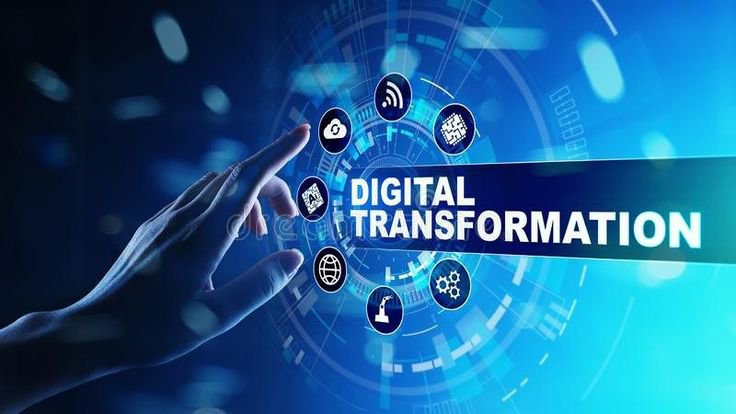Digital Transformation Strategies for Businesses
The digital age is changing industries. Businesses must adapt and use new technologies to stay competitive. Digital transformation isn’t just a luxury anymore; it’s a must for businesses. It helps improve efficiency, boost customer experiences, and drive innovation. Successful digital transformation needs a plan that connects technology with business goals. Companies can waste money on

The digital age is changing industries. Businesses must adapt and use new technologies to stay competitive. Digital transformation isn’t just a luxury anymore; it’s a must for businesses. It helps improve efficiency, boost customer experiences, and drive innovation. Successful digital transformation needs a plan that connects technology with business goals. Companies can waste money on tech that doesn’t meet their needs. This often happens without a clear strategy. They may also miss out on real improvements.
This article explores key business tech trends, the steps for implementing company modernisation, and best practices for a smooth digital transition.
Understanding Digital Transformation

Digital transformation refers to utilising digital technologies in all aspects of a business. That alters the way the firm operates and the way it delivers value to customers. It’s a complete change. It is not merely an IT upgrade. It involves things such as business models, company culture and the way we serve customers. Transformation is equal measures of technology adoption, process reengineering, and workforce adaptation.
Why Digital Transformation Matters
- Enhanced Efficiency: Automates manual processes, reducing time and resource consumption.
- Improved Customer Experience: Uses data-driven insights to personalise interactions and meet customer expectations.
- Competitive Advantage: Enables businesses to innovate, adapt to market changes, and outperform competitors.
- Data-Driven Decision Making: Utilises big data and analytics for smarter business strategies.
- Increased Agility: Enhances responsiveness to industry disruptions and evolving customer demands.
- Better Teamwork: Digital tools and cloud computing make it simple for teams to stay in touch, no matter their location.
- Revenue Growth: Businesses that adopt digital transformation often experience higher sales and profits. This happens because of better efficiency and happier customers.
Key Business Tech Trends Driving Digital Transformation
Emerging technologies like AI, cloud computing, and blockchain are reshaping how businesses operate in the digital age. These innovations drive efficiency, enhance customer experiences, and create new growth opportunities.
Cloud Computing and SaaS Solutions
Cloud computing lets businesses store and access data anywhere. This helps with remote work and teamwork. SaaS solutions offer a budget-friendly and flexible option compared to traditional software. Cloud technology improves disaster recovery. It helps businesses stay running during system failures or cyberattacks.
Artificial Intelligence and Automation
AI tools make things more efficient. They automate tasks, use predictive analytics, and improve customer support. Chatbots and virtual assistants help with this. AI helps businesses analyse large data sets for trend forecasting and planning. Machine learning algorithms can detect inefficiencies in workflows, helping companies optimise processes.
Internet of Things (IoT) and Smart Devices
IoT devices link physical assets to digital systems, helping businesses monitor performance in real-time and boost efficiency. From smart factories to connected supply chains, IoT is revolutionising industries. Smart sensors and automation in fields like manufacturing and logistics help cut downtime and improve resource allocation.
Big Data and Advanced Analytics
Big data enables businesses to extract actionable insights from structured and unstructured data. Advanced analytics tools improve customer segmentation, optimise supply chain management, and enhance marketing efforts. Real-time analytics help businesses quickly adapt to shifting customer preferences and market trends.
Cybersecurity and Data Protection
Due to rising cyber threats, businesses need to focus on cybersecurity. Key measures include encryption, multi-factor authentication, and regular security audits. Compliance with data protection regulations like GDPR and CCPA is crucial. Companies should teach employees about cybersecurity best practices. This helps stop data breaches and phishing attacks.
5G and Enhanced Connectivity
5G technology boosts internet speed and connectivity. This lets businesses use real-time data. It improves cloud services and enhances remote work settings. It makes video calls, virtual reality, and remote check-ups quick and easy.
Steps to Implement a Digital Transformation Strategy

Implementing a digital transformation strategy requires a clear roadmap to ensure success. Businesses must assess their current processes, adopt the right technologies, and foster a culture of innovation to stay competitive in the digital age.
1. Assess Current Business Processes
Before adopting new technology, businesses should check their current workflows. They need to spot inefficiencies and see which areas need digitalisation. Conducting a technology audit can help pinpoint gaps and opportunities for improvement. Involving employees in this process helps make sure digital tools fit operational needs.
2. Define Clear Objectives and Goals
A successful digital transformation strategy should align with business goals. Companies should set clear goals. They may want to use technology to enhance customer engagement, cut costs, or increase revenue. Measurable key performance indicators (KPIs) should be set to track progress.
3. Invest in the Right Technology
Selecting the right digital tools is crucial for effective transformation. Businesses should consider:
- Cloud-based solutions for flexible and scalable operations.
- AI and machine learning tools for automation and predictive insights.
- Cybersecurity solutions to protect digital assets and customer data.
- Collaboration tools to enhance remote work and team productivity.
- IoT devices to improve efficiency and monitoring in logistics and manufacturing.
4. Foster a Digital Culture
Technology alone cannot drive transformation—company culture must also evolve. Businesses should promote digital skills. They can offer training programs for employees. Also, they should encourage a mindset focused on innovation. Leaders should explain the benefits of using digital tools. They must also help employees adjust to these new tools.
5. Implement Change Management Strategies
Resistance to change is a common challenge in digital transformation. Effective change management involves:
- Communicating the benefits of digitalisation to employees.
- Providing ongoing support and training.
- Encouraging a mindset of continuous improvement.
6. Monitor, Evaluate, and Optimise
Digital transformation is an ongoing process. Businesses should track key performance indicators (KPIs) regularly. They need to measure how new technologies affect their work. Then, they can make changes to improve performance. Regular feedback from employees and customers can highlight areas for further improvement.
Overcoming Common Challenges in Digital Transformation
Digital transformation comes with challenges such as resistance to change, integration issues, and cybersecurity risks. Overcoming these obstacles requires strong leadership, strategic planning, and continuous adaptation to evolving technologies.
Budget Constraints
New technology needs money to implement. Use affordable SaaS tools. Apply for government grants. Focus on key areas for early digitalisation.
Resistance to Change
Employees might resist new technologies. They often fear losing their jobs or feel unsure about using new tools. Well-trained employees, input in decisions, and shared success stories can ease transitions.
Data Privacy and Compliance Issues
Handling large volumes of digital data requires strict compliance with regulations. Businesses should adopt strong data protection measures. They need to update security protocols often. Also, educating employees on data privacy best practices is essential.
Integration with Legacy Systems
Many companies struggle to integrate new digital solutions with outdated legacy systems. Phasing out old systems takes time. Using APIs helps with smooth data exchange. Also, teaming up with IT experts ensures a smooth transition.
The Future of Digital Transformation

The future of digital transformation will be driven by AI, automation, and emerging technologies that enhance efficiency and customer experiences. Businesses must stay agile and innovative to remain competitive in an increasingly digital world.
AI and Hyperautomation
AI-driven hyper-automation boosts efficiency by automating complex tasks. This lets businesses run with less human involvement.
Blockchain for Security and Transparency
Blockchain technology enhances security, improves supply chain transparency, and streamlines financial transactions.
Augmented Reality (AR) and Virtual Reality (VR)
AR and VR are changing industries like retail, real estate, and education. They offer immersive experiences and interactive training programs for customers.
Sustainable Digital Transformation
Companies are focusing on energy-efficient cloud computing. They are investing in green data centres and eco-friendly AI. This will help reduce their carbon footprint.
Driving Success Through Digital Transformation: A Blueprint for the Future
Businesses must embrace digital transformation to stay ahead in a fast-changing market. By adopting emerging business tech trends and implementing a well-planned company modernisation strategy, organisations can improve efficiency, enhance customer experiences, and achieve sustainable growth. A smart strategy connects technology to business goals. This link can lead to lasting success in the digital age.